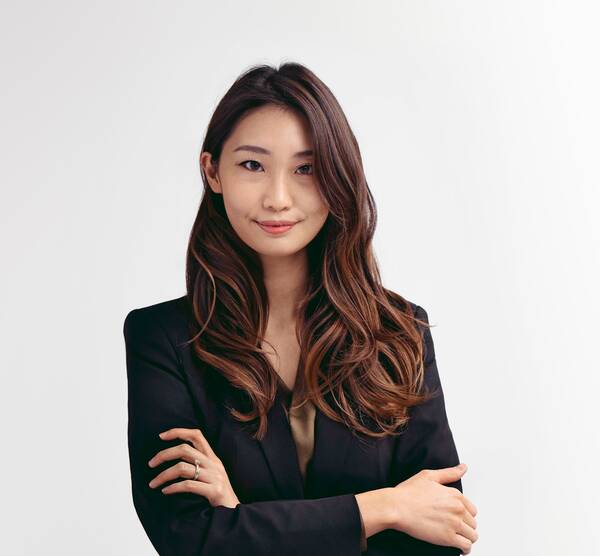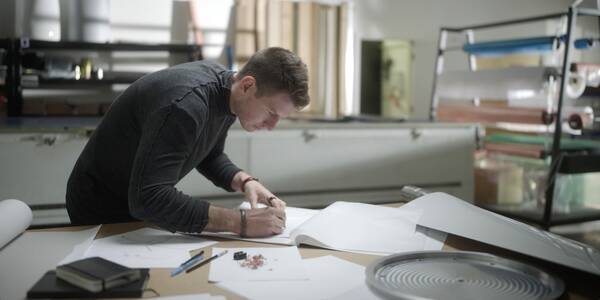profile / alumni / transportation-design
April 09, 2025
By Solvej Schou
Transportation Design alum Jenny Ha creates first impressions at Lucid Motors
ArtCenter’s Transportation Design alumni work for countless global automotive brands. Their ArtCenter education gives them the skills to enter career fields like automotive concept design, interior and exterior automotive design, watercraft design and aircraft design. This story is part of a series on four successful Transportation Design alumni, each with unique creative journeys, who impact their fields in a variety of ways.
For Jenny (Jiyeon) Ha (BS 14), the Palo Alto-based senior manager of exterior design at EV company Lucid Motors, her love of cars and exterior design came early. As a middle school kid growing up in South Korea, she would rip photographs of 1960s classic cars out of magazines. She also enjoyed painting and drawing.
After she moved to Southern California in high school, she learned about ArtCenter from a friend of her relatives. Inspired, she took an ArtCenter extended studies course for teens, in fine art. It was there that she saw a classroom filled with Transportation Design senior projects.

What I love most about exterior design is that it’s about creating a first impression, a first look.
Jenny HaTransportation Design alum

“That’s when I realized, ‘Oh! There’s a job to do this!” she says via Zoom. “Without ArtCenter, I didn’t even know that car design was a career. Seeing that classroom inspired me to go on this path, and my entire life changed.” She spent two years preparing her portfolio to apply to the Transportation Design degree program, and was accepted.
At ArtCenter, Ha participated in an industry-led Sponsored Studio course with Hyundai and social impact Designmatters courses such as Designing for Sustainability. She was also influenced by Adjunct Professor Ricky Hsu, creative lead at American Honda Motor Co., Inc. “He really taught us how important it is to build a strong story and concept before starting the first sketch,” Ha says. “Also, the strongest thing about ArtCenter is that it always tries to keep students connected to design studios not just nearby in California, but also around the world.”
As a student, Ha worked as an exterior design intern at Nissan in San Diego, then at General Motors in Michigan, then at Santa Monica’s Volkswagen/Audi design center. It was at the latter where she got a job, after graduating from ArtCenter, as an exterior designer, doing advanced design and concept work. “Internships are great at helping you find out who you are as a designer,” she says.
Ha transitioned to working at Lucid 10 years ago as a junior exterior designer, then worked her way up to senior manager. At Lucid, she heads up a small team that includes designers and digital and clay modelers. Half of her job is working with engineers and aerodynamics engineers on all aspects of design.

“With a lot of the big companies, there’s a lot of competition,” she says, when asked why she joined the startup EV company. “At Lucid, we have one team with one goal. As a designer, the creative concept part is great, but I wanted to learn and see my concept come to life, and have a chance to follow up the process of making a production car that people can experience.”
At Lucid, she led the design of the exterior of the Lucid Air, the company’s signature sleek luxury electric sedan that features a panoramic glass canopy roof and horizontal nose-blade lighting. She also helped design the electric SUV Lucid Gravity as design manager of the exterior design team. The Gravity has a sporty, yet noble, presence, she says, with ample passenger space. For both vehicles, she particularly enjoyed working with Lucid’s aerodynamic team and lighting team to further improve range efficiency and add an emotional jewel effect when lights turn on.
“What I love most about exterior design is that it’s about creating a first impression, a first look,” says Ha, who then reveals her thinking about design decisions. “At ArtCenter, we always talk about form following function. I really do appreciate a true design, where every feature has a real value to the product, and eventually adds value to the customer. I love combining iconic design features with functionality, while creating product characteristics.”





